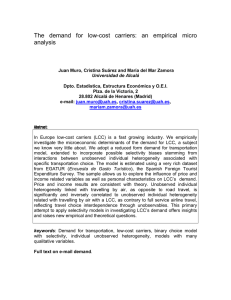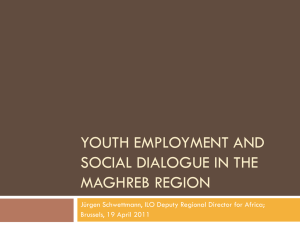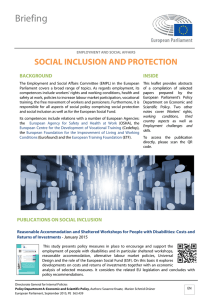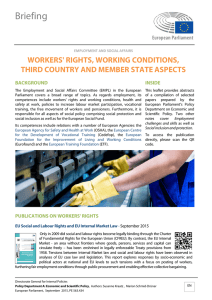to find or not to find a first “significant” job
Anuncio
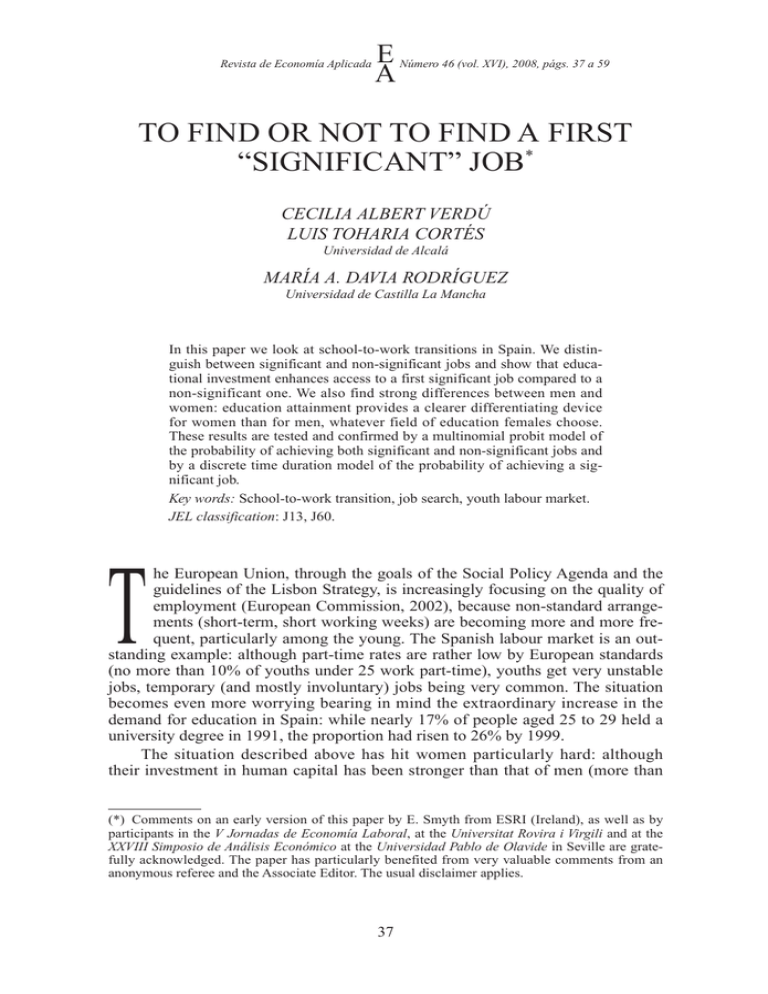
Revista de Economía Aplicada E Número 46 (vol. XVI), 2008, págs. 37 a 59 A TO FIND OR NOT TO FIND A FIRST “SIGNIFICANT” JOB* CECILIA ALBERT VERDÚ LUIS TOHARIA CORTÉS Universidad de Alcalá MARÍA A. DAVIA RODRÍGUEZ Universidad de Castilla La Mancha In this paper we look at school-to-work transitions in Spain. We distinguish between significant and non-significant jobs and show that educational investment enhances access to a first significant job compared to a non-significant one. We also find strong differences between men and women: education attainment provides a clearer differentiating device for women than for men, whatever field of education females choose. These results are tested and confirmed by a multinomial probit model of the probability of achieving both significant and non-significant jobs and by a discrete time duration model of the probability of achieving a significant job. Key words: School-to-work transition, job search, youth labour market. JEL classification: J13, J60. T he European Union, through the goals of the Social Policy Agenda and the guidelines of the Lisbon Strategy, is increasingly focusing on the quality of employment (European Commission, 2002), because non-standard arrangements (short-term, short working weeks) are becoming more and more frequent, particularly among the young. The Spanish labour market is an outstanding example: although part-time rates are rather low by European standards (no more than 10% of youths under 25 work part-time), youths get very unstable jobs, temporary (and mostly involuntary) jobs being very common. The situation becomes even more worrying bearing in mind the extraordinary increase in the demand for education in Spain: while nearly 17% of people aged 25 to 29 held a university degree in 1991, the proportion had risen to 26% by 1999. The situation described above has hit women particularly hard: although their investment in human capital has been stronger than that of men (more than (*) Comments on an early version of this paper by E. Smyth from ESRI (Ireland), as well as by participants in the V Jornadas de Economía Laboral, at the Universitat Rovira i Virgili and at the XXVIII Simposio de Análisis Económico at the Universidad Pablo de Olavide in Seville are gratefully acknowledged. The paper has particularly benefited from very valuable comments from an anonymous referee and the Associate Editor. The usual disclaimer applies. 37 Revista de Economía Aplicada 30% of women under 30 had obtained a University degree in 2000 whereas only 23% of their young male counterparts had the same qualification), their unemployment rates are higher and they face greater difficulties for occupying stable positions. Looking at data from the second quarter of the 2002 Spanish Labour Force Survey (LFS), the duration of contracts is, on average, shorter among women than among men: 67.2% of males and 76.2% of females are hired under temporary contracts that do not even last 6 months. Moreover, the number of young (under 25) women in part-time jobs is triple that of their male counterparts (7.1%). The abovementioned trends have been addressed on several occasions in empirical analysis1. Our aim with this paper is to add further evidence on school-to-work transitions by taking into account two very important features of the Spanish labour market. First, we make the explicit distinction between “significant” and “non-significant” jobs, adding an important twist to previous work, as we study the transition into a somehow stable position in the labour market as opposed to the mere transition to any other short-term or short hours job. The distinction between “significant” and “non-significant” is made possible by the database we use; it refers to the number of weekly hours (at least 20 to define the job as significant) and the length of the contract (at least six months to be significant). The distinction is particularly important in Spain, where the number of very-short-term contracts is very high. The second relevant aspect of our paper is that we look at gender differences by splitting the sample and estimating separate regressions for men and women. As regards the more specific aims of the paper, we intend to uncover the levels and fields of education providing the poorest (and the best) labour market outcomes. In addition, we want to revisit the issue of the links that may exist between education, family background and labour market outcomes. We also try to capture the effect of the business cycle on the quality of the school-to-work transition. To do so, after presenting the data-set used (Section 2), we report the results of a multinomial probit model for estimating labour market outcomes (Section 3). Finally, we study the effect of the time elapsed since leaving education on the labour market outcomes of youth (Section 4). In this case, however, the available information will not allow us to study the distinction between significant and nonsignificant jobs in full detail, so instead of estimating a full competing risks model we will estimate a discrete time duration model of the probability of finding the first significant job. Section 5 concludes. 1. USING THE EULFS AD HOC MODULE OF 2000 TO FIND OUT ABOUT YOUTH EDUCATION AND EMPLOYMENT The Spanish section of the ad hoc module of the European Union Labour Force Survey in 2000 (hereafter, EULFS ad hoc module) enriches the already existing information for the study of school-to-work transitions as it provides details on both the interruption of education and the achievement of the “first significant (1) See Albert et al. (2000), Dolado et al. (2000), Lassibille, et al. (2001), Fernández (2003) and Martínez and Ruiz-Castillo (2002), to mention only studies that have dealt with the Spanish youth labour market, our focus of interest. 38 To find or not to find a first “significant” job job”. The reference period covers the last 10 years before the date of the interview, that is, the whole of the 1990s. This ad hoc module, which is a European-wide endeavour, has already been used for comparative purposes, especially in the papers included in Müller and Gangl (2003) and Kogan and Müller (2003). The sample studied in the EULFS ad hoc module covers individuals aged 15 to 35 in 2000 (16 to 35 in the Spanish case since the legal age to start working is 16) who have left continuous education for the first time in 1991 or afterwards. By “leaving continuous education”, Eurostat means dropping out of full-time or part-time education and training, including vocational and general courses, for at least one year2. Furthermore, as already mentioned, the “first significant” job is defined as a job that started after continuous education was abandoned or interrupted, had a duration of at least 6 months, its working week was at least 20 hours, and it was neither casual work nor part of a training scheme. Our final sample has 14,467 observations, 7,601 males and 6,866 females3. The definitions of the concepts used in the survey may bias the results in some countries. For instance, as Iannelli (2002) points out, the extended use of short-term contracts in Spain (especially for those under 25 years old) makes knowledge of the experience of first short-term contracts relevant in studying early job careers. Our paper takes this particular feature of the Spanish labour market into account and distinguishes between those who achieve their first significant job, those who do not achieve it but still experience some other (“non-significant”) work spell and those who remain jobless between the end of education and the interview. Table 1 describes the most relevant variables used in the analysis. First of all, 60.2% of those who left education between 1991 and 1999 had achieved at least one significant job in 2000. On average, in the 2000 second quarter interview, 30.2% of school-leavers had found at least one non-significant job, whereas 9.6% had not found any job at all. In both cases the proportion is somewhat higher for women than for men. As regards the role of age, the proportion of those who find a significant job tends to increase, with the only exception of the 26-35 age group. Age is highly correlated with the education level. This implies that older individuals are more likely to have reached a higher level of education and left the educational system later. This would explain the higher proportion of those who successfully find a significant employment amongst the older age groups. There is still a high percentage of youths who leave education after completing only lower secondary education, which is more common among men (43.4%) than among women (33%), essentially due to the higher incidence of university education among females (34.5% versus 23% for males). As regards the distribution between vocational and general programmes, Spanish youths tend to prefer the latter. The comparison of the education attainment of youths and their parents reveals (2) Neither interruptions of less than a year nor those due to p/maternity, serious illness, military service or waiting for the diploma or certificate that allows continuing with further education are considered. (3) Those who left school in 2000 (333 observations) have been dropped from the sample because they do not have enough time to find any job. Those whose parents’ educational attainment is unknown (215 observations) have also been excluded. 39 Revista de Economía Aplicada Table 1: DESCRIPTION OF VARIABLES INCLUDED IN THE MODELS (PERCENTAGES) Dependent variable Have significant job experience Have only non-significant job experience Lack any kind of job experience Males Have significant job experience Have only non-significant job experience Lack any kind of job experience Females Have significant job experience Have only non-significant job experience Lack any kind of job experience All 60.2 Under 16 51,8 16 to 20 61,4 21 to 25 26 and over 66,2 57,4 30.2 9.5 35,4 12,8 29,1 9,5 26,8 7,0 33,3 9,3 63.8 56,1 65,8 69,9 62,2 28.9 7.3 34,8 9,0 27,2 7,0 24,3 5,8 30,4 7,5 56.4 45,1 56,5 63,4 52,2 31.7 11.9 36,2 18,8 31,3 12,2 28,8 7,8 36,5 11,4 Independent variables All Males Females Women 47.7 Men 52.3 Highest level of education or training successfully completed when leaving education for the first time Primary 5.8 6.9 4.6 Lower secondary (general programmes) 27.8 32.5 22.6 Upper secondary (general programmes) 11.1 11.0 11.1 Lower vocational training 10.7 10.9 10.4 Upper vocational training 16.3 15.8 16.8 Short university programmes 11.5 8.2 15.2 Long university programmes 16.9 14.8 19.3 Field of education Basic programmes, Literacy and personal development 44.7 50.5 38.2 Teacher training and education science 2.8 0.9 4.9 Arts 2.1 2.0 2.1 Humanities, Social sciences, Journalism & information 4.6 2.9 6.4 Business Administration 15.6 9.8 21.9 Law 3.3 2.4 4.2 Life and Physical sciences, Mathematics & statistics 2.1 1.9 2.3 Computing 2.1 2.8 1.4 Engineering and Engineering Trades 8.6 15.2 1.5 Manufacturing & production, Architecture & building 3.7 5.8 1.4 40 To find or not to find a first “significant” job Table 1: DESCRIPTION OF VARIABLES INCLUDED IN THE MODELS (PERCENTAGES) (continuation) Independent variables Veterinary, Agriculture, Forestry and Fishery Health Welfare and services (Social, Personal, Transport, Environmental protection and Security services) Not specified Highest level of education of one of the parents Primary Lower secondary education (general and vocational programmes) Upper secondary education (general and vocational programmes) Higher education Age when leaving school Under 16 16 to 20 21 to 25 26 and over Continuous job search after leaving education No search for a job Search period: one or two months Search period: between 3 and 5 month Search period: between 6 and 11 month Search period: One year or more Number of observations 1.0 5.3 1.3 2.1 0.7 8.9 3.8 0.4 1.9 0.5 5.9 0.3 62.8 61.8 63.9 19.4 20.2 18.5 9.6 8.2 9.5 8.5 9.7 7.9 30.4 25.2 38.9 5.6 29.5 39.4 25.6 5.6 20.5 38.3 35.7 5.5 23.7 5.3 9.5 13.2 48.3 14467 24.7 5.7 10.1 12.5 47.0 7601 22.6 4.9 8.9 13.9 49.7 6866 Source: EULFS ad hoc module, 2000. Spanish issue. the extraordinary generation gap in investment in education. More than 60% of the parents only have primary education attainment and 8% of them are university graduates, whereas the figures for their children are 6 and 28%, respectively. A large proportion of youths in the sample (44.6%) have undertaken Basic, Literacy and Personal Development Programmes, which correspond to primary and secondary general programmes. The remaining fields of education are included in vocational training and university. The most requested fields are Business Administration (15.6%) and Engineering and Engineering Trades (8.6%). There is a marked gender segregation across fields of study. Programmes related to Business Administration, Health and Services, Humanities and Social Sciences and Teacher Training and Education Science are more frequent among young women, while Engineering and Engineering Trades, Manufacturing and Production-related fields, Architecture and Building as well as Computing are more common 41 Revista de Economía Aplicada among young men. Finally, with respect to continuous job search after leaving school, no remarkable gender differences arise and the distribution is quite polarised: around one in four school leavers have not looked for a job yet, whereas nearly half of them have been searching for a job for one year or more. Finally, there is a feature of the Spanish educational system which should be taken into account: the Spanish education system may be classified as “sequential”, contrasting with the dual northern European model. It relies on the assumption that youths enter the labour market once they have finished formal education. The lack of labour market experience during the education process in sequential models may lead to longer search periods during the school-to-work transition. The educational system in Spain was reformed during the nineties, as new legislation regulating compulsory and non-compulsory secondary education4 came into force. However, the reform did not imply significant changes in the broad structure of the educational system. In particular, its sequential nature was left untouched, as was the basic classification of qualifications. 2. THE PROBABILITY OF GETTING A NON-SIGNIFICANT JOB VERSUS A SIGNIFICANT JOB: A MULTINOMIAL PROBIT APPROACH The empirical strategy adopted here is to estimate a multinomial probit of the probability of achieving one of the three possible labour market outcomes: having a significant job, having experienced at least one non-significant job and not having any job experience at all. If j = 1, 2 and 3 refers to the different possible values of the dependent variable (the three labour market outcomes), following Greene (2003), the structure of the equations of the multinomial probit model are: Uj = x’jβj + εj, j = 1, ..., J, [ε1, ε2, ..., εJ] ∼ N[0, ∑] The term in the log-likelihood that corresponds to the choice of alternative q is Pr[choiceq] = Pr ob[Uq > Uj, j = 1, ..., J, j ≠ q] The probability of this occurrence is Pr[choiceq] = Pr[ε1 – εq > (xq – w1)’β, ..., ε1 – εq > (xq – w1)’β] for the J-1 other choices, which is a cumulative probability from a (J-1)-variate normal distribution. In the previous expressions, X refers to the vector of explanatory variables, β is the vector of coefficients linked to the explanatory variables and β are the stochastic error terms; these error terms are assumed to have independent, standard normal distributions. The reason why we use a multinomial probit rather than the more usual multinomial logit is that the latter requires the assumption of Independence of Irrelevant Alternatives, whereas the multinomial probit relaxes that assumption (4) LOGSE, (Ley de Ordenación General del Sistema Educativo), Law for the general regulation of the education system, was passed in 1990. 42 To find or not to find a first “significant” job (Greene, 2003). The advantage of the multinomial logit is that its coefficients can be directly interpreted as odds ratios (Long, 1997). However, the calculation of marginal effects from the probit estimates is straightforward, and these are generally easier to interpret and understand than the odds-ratios5. The dependent variable takes value 0 (reference) when the interviewee has not found any job at all after leaving education, 1 when a significant job was found and 2 when at least one non-significant job was found (but not a significant job). The choice of the explanatory variables is based on two main theoretical frameworks: the human capital model and the job search model. The independent variables are gender, age (at the moment of leaving education), educational attainment (the highest level of education achieved by the respondent and the field of education), whether the youngster ever looked for a job and, if so, the length of search. Besides, in order to capture the business cycle, the regional employment growth rate for workers under 36 at the moment of leaving education has been included. As for social background, it is proxied by the educational attainment of both parents. The structure of the sample (its strong heterogeneity, given that interviewees left education at different moments in the 1990s) is controlled for through the year when the interviewee left education. Table 2 presents the results of our estimations6. Three different specifications have been tested. They have a common set of variables and a specific set of human capital variables for each of them. The variables indicating human capital are the educational attainment of the respondent (Model I), the field of education (Model II) and the educational attainment of the parents (Model III). Due to the strong correlation between these three variables, we have decided to estimate three complementary specifications to avoid the problems which would arise if we included all of them in a single model. The common variables are: age when the individual left education, an indicator of the business cycle when the individual left education and the search (and length of longest search period) for employment. The first one is supposed to be correlated with educational attainment and potential experience, therefore, with employment expectations, whereas the second one is expected to have a positive sign but only to a certain extent, given that very long search periods might act as negative productivity signals. Other possibilities may also arise, such as loss or obsolescence of skills and decreases in search intensity. The structure of the sample is controlled through the year when the interviewee left education. In order to capture business cycle factors, the regional employment year-to-year growth rate for workers under 36 at the moment of leaving education has been included and we expect its sign to be positive. (5) We have explored the possibility of selection bias in our sample due to the fact that we only study youths who left education during the nineties, who are the only ones that have been able to get significant jobs, according to the definition of such jobs. We have used the Heckman (1979) twostep method of correction for sample selection: the hypothesis of random sample selection was confirmed. Results for this test are not shown, but they are available from the authors upon request. (6) Only marginal effects are reported, for the sake of brevity and clarity. Full estimation results are available from the authors upon request. 43 Revista de Economía Aplicada Table 2. MULTINOMIAL PROBIT REGRESSION. FINDING A SIGNIFICANT VERSUS A NON SIGNIFICANT JOB. BASELINE CATEGORY: NOT FINDING ANY JOB AT ALL. MARGINAL EFFECTS Males Find a non signif. job Find a signif. job Females Find a non signif. job Find a signif. job Model I: Highest level of education or training successfully completed when leaving education for the first time (ref: Primary) Lower secondary Upper secondary Lower vocational Upper vocational Short university programmes Long university programmes -0.073*** (-3.773) -0.088*** (-3.623) -0.082*** (-3.477) -0.122*** (-5.418) -0.134*** (-5.162) -0.152*** (-6.084) 0.108*** (5.219) 0.117*** (4.563) 0.120*** (4.884) 0.176*** (7.545) 0.175*** (6.461) 0.186*** (6.976) -0.088** 0.179*** (-3.278) (6.148) -0.126*** 0.201*** (-4.193) (6.120) -0.144*** 0.244*** (-5.053) (8.041) -0.153*** 0.258*** (-5.368) (8.405) -0.164*** 0.270*** (-5.533) (8.480) -0.222*** 0.334*** (-8.214) (11.354) Model II: Field of education (ref: Basic programmes, Literacy and Numeracy and personal development) Teacher training and education science Arts Humanities, Social sciences, Journalism & information Business Administration Law Life and Physical sciences, Mathematics & statistics Computing Engineering and Engineering Trades Manufacturing & production, Architecture & building Agriculture, forestry and fishery, Veterinary 0.049 (0.828) -0.103** (-2.691) -0.034 (-0.911) -0.041* (-1.984) -0.013 (-0.323) 0.025 (0.532) -0.068* (-2.083) -0.048** (-2.792) -0.027 (-1.112) -0.064 (-1.443) -0.133* (-2.198) 0.097* (2.334) 0.036 (0.930) 0.056* (2.574) -0.006 (-0.133) -0.020 (-0.419) 0.077* (2.240) 0.085*** (4.813) 0.059* (2.404) 0.093* (2.052) 44 -0.011 (-0.345) -0.023 (-0.536) -0.039 (-1.332) -0.061*** (-3.501) -0.163*** (-6.030) -0.084* (-2.031) -0.107* (-2.412) -0.084 (-1.763) -0.092* (-1.987) -0.024 (-0.338) 0.060 (1.846) 0.069 (1.507) 0.054 (1.737) 0.111*** (5.968) 0.175*** (5.324) 0.083 (1.764) 0.148** (2.994) 0.160** (3.193) 0.141** (2.813) 0.114 (1.555) To find or not to find a first “significant” job Table 2. MULTINOMIAL PROBIT REGRESSION. FINDING A SIGNIFICANT VERSUS A NON SIGNIFICANT JOB. BASELINE CATEGORY: NOT FINDING ANY JOB AT ALL. MARGINAL EFFECTS (continuation) Males Health Welfare and services(+) Not specified Females Find a non signif. job Find a signif. job Find a non signif. job 0.026 (0.609) 0.039 (0.923) 0.093 (1.204) -0.019 (-0.444) -0.005 (-0.123) -0.065 (-0.825) -0.034 (-1.452) -0.053* (-2.119) -0.006 (-0.066) Find a signif. job 0.069** (2.787) 0.108*** (4.059) 0.089 (1.002) Model III (Highest education attainment of one of the parents (ref: primary) Lower secondary Upper secondary Higher education -0.025 (-1.869) -0.012 (-0.611) -0.033 (-1.606) 0.035* (2.505) 0.013 (0.658) 0.019 (0.890) 0.003 (0.195) -0.041* (-1.983) -0.074*** (-3.360) 0.020 (1.208) 0.067** (3.044) 0.081*** (3.339) Rest of independent variables for Model I Age when leaving education (ref: under 15) 16 to 20 years old 21 to 25 years old Over 26 years old -0.045** (-2.680) -0.036 (-1.460) 0.052 (1.417) 0.064*** (3.644) 0.067** (2.623) -0.021 (-0.557) -0.026 (-1.211) -0.005 (-0.167) 0.089* (2.327) 0.070** (3.032) 0.076** (2.621) -0.033 (-0.842) Continuous job search after leaving education (ref: No search) One or two months between 3 and 5 months between 6 and 11 months One year or more -0.171*** (-9.248) -0.069*** (-3.691) 0.022 (1.156) 0.092*** (6.914) 0.228*** (12.158) 0.120*** (6.344) -0.010 (-0.518) -0.107*** (-7.707) -0.183*** 0.293*** (-8.355) (13.006) -0.110*** 0.221*** (-5.289) (10.313) -0.013 0.086*** (-0.668) (4.133) 0.101*** -0.077*** (6.892) (-4.900) -0.093*** (-3.880) 0.164*** (6.800) -0.196*** 0.330*** (-9.299) (15.259) Leaving year (ref: 1999) 1991 45 Revista de Economía Aplicada Table 2. MULTINOMIAL PROBIT REGRESSION. FINDING A SIGNIFICANT VERSUS A NON SIGNIFICANT JOB. BASELINE CATEGORY: NOT FINDING ANY JOB AT ALL. MARGINAL EFFECTS (continuation) Males 1992 1993 1994 1995 1996 1997 1998 Youth employment growth rate Number of observations Log pseudolikelihood Wald chi2(44) Prob > chi2 Females Find a non signif. job Find a signif. job Find a non signif. job Find a signif. job -0.050 (-1.759) -0.061 (-1.907) -0.074** (-2.803) -0.067** (-2.854) -0.065** (-2.598) -0.032 (-1.314) -0.005 (-0.195) 0.001 (0.671) 0.119*** (4.120) 0.136*** (4.192) 0.138*** (5.137) 0.133*** (5.611) 0.115*** (4.545) 0.082** (3.259) 0.033 (1.248) -0.001 (-0.594) -0.181*** (-7.324) -0.190*** (-6.959) -0.174*** (-7.231) -0.161*** (-7.422) -0.152*** (-6.526) -0.142*** (-6.409) -0.098*** (-4.135) 0.001 (0.491) 0.316*** (12.460) 0.325*** (11.594) 0.302*** (12.152) 0.286*** (12.723) 0.271*** (11.171) 0.252*** (10.815) 0.191*** (7.601) 0.001 (0.716) 7601 6866 -6012,895 750.04 0.000 -6071.783 879.87 0.000 t-statistics in parentheses. (*) significant at 10% (**) significant at 5% and (***) significant at 1%. (+) (Social, Personal, Transport, Environmental protection and Security services). Source: EULFS ad hoc module, 2000. Spanish issue. In Table 2 the marginal effects for the set of common variables are reported only for model I, while only the results for the specific (differentiating) variables are shown in the case of the two other specifications. The three models have been estimated separately for males and for females. A joint estimation7 was also carried out; it showed that, keeping everything else constant, men have a higher (7) These results are not shown for the sake of brevity but they are available from the authors upon request. 46 To find or not to find a first “significant” job probability of finding a significant job than women and that the distance is somewhat lower for non-significant ones compared to remaining fully jobless. The results of the first specification (Model I) suggest that men with long university programmes, short university and upper vocational training are much more likely to get a significant job while those with the lowest level (the reference category) show the lowest probability. This implies that the length of the programme does not appear to be a significant factor within higher education. In the case of women, the opposite is true: the longer their education, the higher the probability of finding a significant job. In fact, long university programmes provide the highest probability of finding a “significant” job. As for non-significant jobs, the reverse is true, as should be expected: higher education reduces the probability of getting a non-significant job (as opposed to the other two alternatives together). As regards the field of education (Model II), there are interesting differences. First, Teacher Training and Education sciences show negative marginal effects for men and is not significant in the case of women. Secondly, the most successful fields for men are Engineering and Engineering Trades and Manufacturing and Production, followed by Arts, Business Administration, Computing, Manufacturing and Production, Architecture and building and Agriculture, forestry, fishery and veterinary (the last five fields being significant only at the 10 percent level) Thirdly, women experience positive returns not only in the fields just mentioned (with the exception of Arts and Agriculture, forestry, fishery and veterinary) but also in Law, Health related studies and Welfare and services. Finally, Humanities, Social Sciences, Journalism and Information Sciences, as well as Physical Sciences, Mathematics and Statistics (for both men and women), Law, Health and Welfare and Services (for men only) and Arts and Agriculture, Forestry and Fishery (for women only) do not show any positive effects on finding a significant job. Regarding the educational attainment of the parents (Model III), upper secondary and higher education positively influences the school-to-work transition for women. On the whole, the models which have been estimated show that human capital variables positively influence the process of getting significant jobs. However, that influence is not simple and straightforward, as we have found important variations across and within the three sets of variables introduced in the various models estimated. Human capital does matter but in a qualified way: the fields of education chosen and the family background are also important determinants of later job success. As regards the common set of variables, which show similar effects across the three models estimated, age when leaving education is correlated with education attainment but, once the latter is controlled for, age still exerts a positive influence in finding a significant job, though only up to a point, as being over 25 when leaving education negatively affects the probability of finding a significant job. In addition, it should be noticed that short search periods improve the likelihood of getting a significant job compared to non-search against non-employment. This effect is more important among women than among men. As regards 47 Revista de Economía Aplicada the time invested in job search8, looking for a job after leaving education is usually linked to a higher probability of getting a job (and, especially, a significant one) compared with not looking at all: short search periods (less than 6 months) increase the likelihood of getting a significant job. But when the search goes on up to one year this probability tends to vanish, the effect even becoming negative in the case of men finding a significant job and disappearing in the case of women entering significant jobs. Finally, we have tried to capture the business cycle and the situation in the labour market when youths left education through the year-by-year regional youth employment growth rate, which should increase employment possibilities for school leavers. The results hardly show a significant link between the economic cycle and the exit from non employment. 3. THE PROBABILITY OF GETTING A SIGNIFICANT JOB: A DURATION MODEL APPROACH In the previous section, we have estimated a model of the probability of eventually obtaining a significant or a non-significant job versus remaining jobless over the whole period of observation. Given that we are dealing with a timerelated process, it is clear that the best way to model it is through the use of a duration model. Since we can observe time only at one-month intervals, the most appropriate procedure would be to estimate a discrete-time duration model. Given that we have a multiple exit setup (significant and non-significant jobs), a competing risks framework would be the most appropriate. Unfortunately, however, and as already mentioned, our data set allows us to perform such an analysis only for significant jobs, as only in that case does it provide information about both the date when education finished and the date when the first significant job started. Before turning to the estimation of the duration model, we have observed the process of getting a significant job in a descriptive way through a set of KaplanMeier survival functions. In Figures 1 and 2 we show two of them, the first showing how women significantly spend more time in non employment or non-significant jobs, and the second showing how youths who have gone beyond compulsory education (who have remained in the education system after age 16) are more likely to leave non employment. Similar survival functions show the positive impact of education and the significant differences between following a particular field of education compared to just undergoing general programmes9. In order to disentangle the explanatory power of these variables (among many others) on the transition into a significant job, we have performed a discrete (8) Continuous period of job search is defined as the longest period (of more then one month) elapsed between leaving education and the time of the interview, in which the interviewed person has not had a job and actively looked for one. The youth, therefore, might have experienced several search periods but would only report the longest one. Moreover, this search spell could have taken place after the achievement of the first significant job, although we suppose (as seems reasonable) that it occurred before. (9) The plots of all the hazard functions are not reproduced here for the sake of brevity. They are available from the authors upon request. 48 To find or not to find a first “significant” job Figure 1: SURVISAL IN NON EMPLOYMENT OR NON-SIGNIFICANT EMPLOYMENT, KAPLAN MEIER ESTIMATES BY GENDER Kaplan-Meier survival estimates, by sex 1.00 0.75 0.50 0.25 0.00 0 50 100 analysis time Survivor functions, by sex, Spanish module (sts) sex = Women 150 sex = Men Source: EULFS ad hoc module, 2000. Spanish issue. time (grouped data) proportional hazards regression model10 which controls for unobserved heterogeneity under the assumption that it follows a Gamma mixture distribution11.We have decided to use this specification for two reasons. First, the shape of the hazard does not fit any of the functions used in the parametric (continuous time) models12. Therefore, we have controlled for the possible shape of the baseline hazard function by using dummies for several periods (the coefficients for these dummies are not shown for reasons of space but are available upon request). Second, we control for unobserved heterogeneity, which improves the quality of the model: parameters indicating duration dependence or estimating (10) We have used the pgmhaz8 STATA module designed by Stephen Jenkins. (11) The application used estimates two models by maximum likelihood (Jenkins, 2004): the first is a Prentice-Gloeker (1978) model, and the second is a Prentice-Gloeker model incorporating a Gamma mixture distribution to summarize unobserved individual heterogeneity, as proposed by Meyer (1990). For further details, see Jenkins (2004). (12) Following Blossfeld and Rohwer (2002, page 180), any substantive conclusion based on a time-dependent parametric model necessarily rests on a series of untested and/or untestable assumptions: (1) that there is indeed the supposed causal factor, (2) that this causal factor leads to a specific shape of the transition rate (via an assumed causal mechanism), and (3) that the measure of time is a reasonably good proxy for the path of the unobserved factor. In summary, a strong theory is needed for these empirical applications. 49 Revista de Economía Aplicada Figure 2: SURVISAL IN NON EMPLOYMENT OR NON-SIGNIFICANT EMPLOYMENT, KAPLAN MEIER ESTIMATES BY AGE WHEN LEAVING EDUCATION Kaplan-Meier survival estimates, by leaving_age 1.00 0.75 0.50 0.25 0.00 0 50 100 analysis time Survivor functions, by leaving age, Spanish module (sts) 150 leaving_age = under 16 leaving_age = 16-20 years old leaving_age = 21-25 years old leaving_age = 26-34 years old Source: EULFS ad hoc module, 2000. Spanish issue. the transition rates are often biased due to omitted relevant variable(s) in the specification. By controlling for this unobserved heterogeneity, even though we need to accept a distributional assumption, we may contribute to obtaining “true” versus “apparent” time dependences in the transition rate. The distributional assumption in this case is a Gamma mixture distribution13. In parallel with the strategy adopted in the multinomial probit in Section 3, we have estimated three specifications of the model. Each of them includes a set of variables related to human capital investment: level of education, field of education and parental education. Besides, we have a common set of covariates in the three specifications: the regional youth employment growth rate at the moment when the individual left the education system, age when leaving education and length of search time. Given that the coefficients for the common set of variables are similar across the three specifications, we only report the coefficients for the first of them. Table 3 shows the main results of our estimations, displaying both the hazard ratios and the standard coefficients. The first thing we stress is that the size of the (13) We have also performed the same specifications assuming instead a discrete mixture distribution as a consistency check, and again we obtain evidence suggesting that unobserved heterogeneity has been controlled for. Results are available upon request. 50 To find or not to find a first “significant” job variance of the Gamma mixture distribution relative to its standard error suggests that unobserved heterogeneity is significant in this data set, so we prefer this second specification. The likelihood ratio test of the model with unobserved heterogeneity versus the model without unobserved heterogeneity suggests the same conclusion. As regards the effect of the main covariates, the level of education (Model I) contributes positively to finding a significant position, with upper vocational training defining the maximum value for men and long university programmes for women. For example, once unobserved heterogeneity is controlled for, men with upper vocational training are three times as likely as those with primary education to find a significant job, and men with University degrees are more than twice as likely to succeed. Moreover, the coefficients of educational level are, in nearly all categories, higher amongst women, meaning that education acts as a more effective screening device amongst women than amongst men. The fields of education (Model II) show very diverse outcomes: whereas some fields do not significantly increase the odds of getting a significant job compared to individuals with no relevant specification (coming from primary or general secondary programmes), others contribute considerably to initial success in the labour market. Amongst the former we may stress Teacher Training, Humanities and Social Sciences for both genders, Law, Life and Physical Sciences and Statistics for men, as well as Agriculture, Health and Welfare services for men. The field of education is a more relevant signalling device for women than for men. Women are very often positively affected by fields of education that do not make any difference amongst men. The most successful fields of education are Engineering, Computing, Manufacturing and Production for both genders, whereas many fields are significant for women, the exceptions being Teacher Training and Education Science, Arts, Humanities, Social Sciences, Journalism and Information and Life and Physical Sciences, Mathematics and Statistics. The last human capital indicator is the level of education of the more educated parent (Model III): once unobserved heterogeneity is controlled for, the effect of parental education vanishes in nearly all cases. Before controlling for unobserved heterogeneity, parents with higher education tended to contribute to the likelihood of entering a significant job in the case of young women and parents with lower secondary education tend to positively influence the success of young men. It is interesting to see how the level of significance of explanatory variables increases when unobserved heterogeneity is taken into account in variables related to individual human capital but when an indirect measure is used the impact is less significant. As regards the common set of explanatory variables, the effect of the business cycle is, as expected, positive and significant, though not very strong. Every single percentage point of regional youth employment growth results in, approximately, a 5% increase in the probability of getting a significant job, the proportion varying across genders and specifications. The age at which education is finished is positively correlated with the probability of getting a position once the level of education is controlled for. This reinforces the effect of the level of education and may also contribute to showing an effect of maturity on the chances of employment, given the same level of education. 51 Controlling for unobserved heterogeneity Not controlling for unobserved heterogeneity Controlling for unobserved heterogeneity Women 52 0.472*** (6.06) 0.524*** (5.85) 0.586*** (6.54) 0.820*** (9.52) 0.783*** (8.06) 0.697*** (7.41) 2.008*** 2.187*** 2.272*** 1.797*** 1.688*** 1.604*** 0.766*** (5.63) 0.796*** (4.91) 1.007*** (6.17) 1.284*** (8.16) 1.085*** (5.94) 0.948*** (5.36) 2.580*** 2.960*** 3.611*** 2.736*** 2.217*** 2.151*** 0.409*** (3.56) 0.437*** (3.47) 0.712*** (5.74) 0.694*** (5.68) 0.629*** (4.95) 0.821*** (6.39) -0.202 (-1.23) Arts 0.293** (2.63) Humanities, Social Sciences, Journalism 0.098 & Information (0.95) Teacher training and education science 1.104 1.341** 0.817 -0.261 (0.85) 0.488** (2.16) -0.206 (1.06) 0.814 1.628** 0.770 0.053 (0.53) 0.153 (1.17) 0.071 (0.80) Model II: Field of education (ref: Basic programmes, Literacy and Numeracy and personal development) Long university programmes Short university programmes Upper vocational Lower vocational General upper secondary Compulsory education (lower secondary) 1.074 1.166 1.054 2.272*** 1.876*** 2.001*** 2.038*** 1.547*** 1.505*** 0.007 (0.04) 0.343 (1.35) 0.233 (1.39) 0.734*** (3.72) 0.709*** (3.25) 1.246*** (5.74) 1.292*** (6.03) 1.129*** (5.08) 1.370*** (6.08) Model I: Higher level of education or training successfully completed when leaving education for the first time (ref: Primary) 1.262 1.410 1.007 3.934*** 3.092*** 3.641*** 3.475*** 2.032*** 2.083*** Coefficient odds ratio Coefficient odds ratio Coefficient odds ratio Coefficient odds ratio (t) (t) (t) (t) Not controlling for unobserved heterogeneity Men WITH AND WITHOUT CONTROL FOR UNOBSERVED HETEROGENEITY Table 3: PROBABILITY OF GETTING A SIGNIFICANT JOB. DURATION MODEL (DISCRETE TIME PROPORTIONAL HAZARD MODEL) Revista de Economía Aplicada 53 Not specified Welfare and Services (...) Manufacturing and Production, rchitecture and Building Agriculture, Forestry and Fishery, Veterinary Health Engineering and Engineering Trades Life and Physical Sciences, Mathematics and Statistics Computing Law Business Administration Controlling for unobserved heterogeneity Not controlling for unobserved heterogeneity Controlling for unobserved heterogeneity Women 0.285*** (4.98) 0.029 (0.26) -0.011 (-0.08) 0.395*** (4.12) 0.368*** (7.76) 0.300*** (4.42) 0.240* (1.86) 0.144 (1.17) 0.139 (1.10) -0.206 (-0.93) 0.814 1.150 1.155 1.271* 1.350*** 1.445*** 1.484*** 0.989 1.029 1.330*** 0.368*** (3.23) -0.189 (0.87) -0.132 (0.55) 0.430** (2.29) 0.581*** (6.11) 0.537*** (4.01) 0.391 (1.52) 0.259 (1.11) 0.184 (0.73) -0.378 (0.95) 0.686 1.202 1.296 1.479 1.711*** 1.788*** 1.537** 0.877 0.828 1.445*** 0.358*** (6.50) 0.289** (2.95) 0.221 (1.63) 0.448** (3.06) 0.406** (2.73) 0.547*** (3.97) 0.518* (2.50) 0.271*** (3.66) 0.391*** (4.93) 0.014 (0.06) 1.015 1.479*** 1.311*** 1.679* 1.729*** 1.501** 1.566** 1.247 1.335*** 1.430*** 0.719*** (6.70) 0.352* (1.81) 0.362 (1.43) 0.906*** (3.07) 0.735** (2.41) 1.111*** (3.93) 1.133*** (2.77) 0.587*** (4.08) 0.676*** (4.42) -0.046 (0.09) 0.956 1.966*** 1.798*** 3.105*** 3.038*** 2.086** 2.473*** 1.436 1.422* 2.053*** Coefficient odds ratio Coefficient odds ratio Coefficient odds ratio Coefficient odds ratio (t) (t) (t) (t) Not controlling for unobserved heterogeneity Men Table 3: PROBABILITY OF GETTING A SIGNIFICANT JOB. DURATION MODEL (DISCRETE TIME PROPORTIONAL HAZARD MODEL) WITH AND WITHOUT CONTROL FOR UNOBSERVED HETEROGENEITY (continuation) To find or not to find a first “significant” job 54 26-34 years old 21-25 years old 16-20 years old 0.285*** (5.62) 0.482*** (7.80) 0.510*** (6.06) Other variables included in Model I Age when leaving education (ref: under 16) Higher education Upper secondary education 0.137*** (3.36) 0.108* (1.97) 0.117* (2.03) 1.665*** 1.619*** 1.329*** 1.124 1.114 1.147 1.018 1.154 1.140* 0.732*** 2.079*** (7.26) 1.165*** 3.205*** (8.77) 1.363*** 3.907*** (7.50) 0.131* (1.65) 0.143 (1.33) 0.018 (0.15) Model III: level of education of the more educated parent (ref: primary) Lower secondary education Controlling for unobserved heterogeneity Not controlling for unobserved heterogeneity Controlling for unobserved heterogeneity Women 0.439*** (6.15) 0.645*** (7.64) 0.701*** (6.38) 0.034 (0.69) 0.139* (2.26) 0.209*** (3.29) 2.015*** 1.906*** 1.551*** 1.2324 1.1491 1.0346 1.185 1.064 0.971 1.098*** 2.997*** (7.61) 1.439*** 4.215*** (8.35) 1.496*** 4.465*** (6.82) -0.029 (0.31) 0.062 (0.51) 0.170 (1.32) Coefficient odds ratio Coefficient odds ratio Coefficient odds ratio Coefficient odds ratio (t) (t) (t) (t) Not controlling for unobserved heterogeneity Men Table 3: PROBABILITY OF GETTING A SIGNIFICANT JOB. DURATION MODEL (DISCRETE TIME PROPORTIONAL HAZARD MODEL) WITH AND WITHOUT CONTROL FOR UNOBSERVED HETEROGENEITY (continuation) Revista de Economía Aplicada Controlling for unobserved heterogeneity Not controlling for unobserved heterogeneity Controlling for unobserved heterogeneity Women 55 0.000 -20343.63 274601 0.008 1.021*** 0.788*** -15577.304 217589 -1.316*** 0.268*** -0.238*** (13.39) (-5.3) 1.035*** 0.063*** 1.065*** 0.021*** (10.92) (11.16) 0.015 0.811*** -4.762 (10.33) (-23.14) -0.576* (9.29) 2.249*** (10.07) 269.367 0.721*** 0.000 -20478.312 274601 (12.74) (1.67) -0.326*** (-9.12) 0.035*** (11.81) -4.223 (-28.72) Absolute value of z statistics in parentheses. * significant at 10%; ** significant at 5%; *** significant at 1%. Source: EULFS ad hoc module, 2000. Spanish issue. LR test of Gamma var. = 0 (Unobserved heterogeneity) Prob. > = chibar2 Log likelihood Observations (individual-period) Gamma variance ln_varg _constant Intercept Youth employment growth rate Searched for a job after leaving education -15500.199 217589 154.209 2.516*** -1.334*** 0.263*** (9.67) 0.035*** 1.035*** (9.86) -1.172*** (2.59) 0.923*** Developed some sort of active job search from non employment for at least one month after leaving education (ref: did not search) Coefficient odds ratio Coefficient odds ratio Coefficient odds ratio Coefficient odds ratio (t) (t) (t) (t) Not controlling for unobserved heterogeneity Men Table 3: PROBABILITY OF GETTING A SIGNIFICANT JOB. DURATION MODEL (DISCRETE TIME PROPORTIONAL HAZARD MODEL) WITH AND WITHOUT CONTROL FOR UNOBSERVED HETEROGENEITY (continuation) To find or not to find a first “significant” job Revista de Economía Aplicada Youths who look for a job for at least one month (we could label this as unemployment) are less likely to get a significant job than those who did not need to search, which is a fairly reasonable result given the reference category and the fact that, amongst those who had to look for a job, there is a high proportion of long time searchers/unemployed, which may explain a lower likelihood, everything else constant, of finding a significant position over time. As for the time dummies that account for the effect of the time elapsed since education finished (not shown for the sake of brevity but available upon request), we observe, after controlling for unobserved heterogeneity, a significant and continuous decrease in the probability of getting a significant position compared to those who left education and did not have to wait even a month to enter a significant job (i.e., those who did not have any unemployment experience), which is consistent with the job search estimate. 4. CONCLUSIONS The Spanish labour market is characterised by a generalised increase in the demand for education and, at the same time, persistent problems for finding quality jobs. This is particularly true in the case of women, since they have made stronger efforts in education but they get worse labour market outcomes than men. We have studied the main patterns in the school-to-work transition in the nineties using, as an empirical strategy, a multinomial decision model, so that the patterns of access to both significant and non-significant jobs have been analysed. We have afterwards reinforced the analysis with a duration model that includes the effect of time although it does not distinguish between access to significant and non-significant jobs. Our results show that the educational investment of youths yields higher returns in terms of increasing the probability of finding a first significant job versus finding a non-significant one. University studies and upper vocational training provide the best signals in the labour market. Nevertheless, this should not lead to the conclusion that generalised increases in educational attainment will reduce their overall youth unemployment or the difficulties of finding a quality job. Demand factors should also be taken into consideration. As regards gender differences, education is a stronger screening device for women than for men. Nevertheless, women tend to choose the “worst” fields of study in terms of employability, which may be a crucial explanatory variable for their poorer labour market outcomes. These fields are those which apparently do not contribute to employability across either males or females, and are typically more requested by females. This trend among women to choose those fields of education where employment opportunities at the beginning of their employment careers are scarce or, at least, register excess supply, does not necessarily mean that they do not take rational decisions in order to maximise their lifetime labour income. On the contrary, women tend to choose the levels and fields of education that enable them to enter occupations and sectors where there are lower risks of gender segregation and higher job stability. These are, essentially, jobs in the public sector, such as education and health services and higher education is required 56 To find or not to find a first “significant” job to access them. On the contrary, the fields of education that contribute most to the employability of both genders are also the ones that are more requested by men (with the exception of Welfare and Services). In any case, an increase in education in the fields that provide a better signal to employers might flood the market if the demand for labour did not also increase. This last aspect is where labour market policies should devote more resources. In other words, public policies should foster demand for qualified young workers in order to avoid badly matched highly qualified youth pushing poorly qualified out of the labour market. It is important to remember that we have tried to measure the effect of human capital during the first years of the working career. Therefore, we can not rule out the possibility that certain levels and fields of educations, as well as certain family backgrounds that initially do not enhance the probability of finding a significant job, may have long term positive effects during later stages of the working life. As for the level of education of the parents, it is very interesting to see how the level of significance of the explanatory variables increases when unobserved heterogeneity is taken into account. At any rate, our results tend to suggest that a higher level of education of parents tends to exert a positive influence for women but is not significant for men. Finally, another interesting result concerning youth employment policies is the positive effect of job search on success rates and the likely discouragement we find in long-term job-seekers. This may be indicative of the need for fostering dynamism in youth job search processes. More research should be done in order to find out whether this result indicates duration dependence. Given that short periods are linked to better labour market outcomes, we think that the already prevalent model of active labour market policies targeted at youth, is effective and needs to be kept and reinforced, since it reduces transitions to long-term unemployment. As a matter of fact, this focus on the short-term unemployed turns out to be one of the recommendations of the Lisbon Targets and the European Employment Strategy. E A REFERENCES Acemoglu, D. (2001): “Good jobs versus bad jobs, Journal of Labor Economics, vol. 19, pp. 1-22. Albert, C., J.P. Juárez, R. Sánchez and L. Toharia (2000): “La transición de la escuela al mercado de trabajo en España en la década de los noventa”, Papeles de Economía Española, vol. 86, pp. 42-58. Ashenfelter, O. and J. Ham (1979): “Education, Unemployment, and Earnings”, Journal of Political Economy, vol. 87, n. 5, pp. S99-S116. Baltagi, B.H. (1999): Econometrics, 2nd revised edition, Springer-Verlag. Berlin, Heidelberg, New York. Blossfeld, H.P and G. Rohwer (2002): “Techniques of Event History Modeling, New Approaches to Causal Analysis”. Lawrence Erlbaum Associates, Publishers. London. 57 Revista de Economía Aplicada Becker, G. (1964): “Human capital: A theoretical and empirical analysis with special reference to education”, National Bureau of Economic Research, Columbia University Press. New York. Card, D. (1999): “The casual effect of education on earnings”, in Ashenfelter, O. and D. Card (eds.): Handbook of Labor Economics, volume 3A, Princeton University, Princeton, NJ, USA. Dolado, J.J., F. Felgueroso and J.F. Jimeno (2000): “Youth labour markets in Spain: Education, training, and crowding-out”, European Economic Review, vol. 44, n. 4-6, pp. 943-956. European Commission (2002): “Employment in Europe, 2002”. Office for Official Publications of the European Communities, Luxembourg. Fernández, C. (2003): “The role of education vis-à-vis job experience in explaining the transitions to employment in the Spanish youth labour market“ FEDEA working paper, n. 2003-06. Greene, W.H. (2003): “Econometric Analysis. Vth edition”. Prentice Hall. Hausman, J. and D. McFadden (1984): “Specification test for the multinomial logit model”, Econometrica, vol. 52, n. 5, pp. 1219-1240. Heckman, J.J. (1979): “Sample selection bias as a specification error”, Econometrica, Vol. 47, n. 1, pp. 153-162. Iannelli, C. (2002): “Evaluation and analyses of the LFS 2000 ad hoc module data on School-to-work transitions”. Report on data quality and cross-country comparability, Centre for Educational Sociology University of Edinburgh. Jenkins, S.P. (2004):”PGMHAZ8. Stata module to estimate discrete time (grouped data) proportional hazards models”. Stata Technical Bulletin STB-39. Kogan, I. and W. Müller (eds.) (2003): “School-to-work transitions in Europe: Analyses of the EULFS 2000 ad hoc module“, Mannheimer Zentrum für Europäische Sozialforschung. Mannheim. Lassibille, G., L. Navarro, I. Aguilar and C. de la O. (2001): “Youth transition from school to work in Spain”, Economics of Education Review, vol. 20, pp. 139-149. Long, J. Scott (1997): “Regression models for categorical and limited dependent variables”, Advanced Quantitative Techniques in the Social Sciences, n. 7, Sage Publications, Thousand Oaks, CA. Meyer, B.D. (1990): “Unemployment insurance and unemployment spells”, Econometrica, vol. 58, n. 4, pp. 757-782. Mortensen, D. T. and C.A. Pissarides (1999): “Developments in models of search in the labor market”, in Ashenfelter., O. and D. Card (eds.), Handbook of Labor Economics, volume 3B, Princeton University, Princeton, NJ, USA. Müller, W. and M. Gangl (eds.) (2003): “Transitions from Education to Work in Europe. The Integration of Youth into the European Union Labour Market”, Oxford University Press. Oxford. OECD (1998): “Getting started, settling in: the transition from education to the labour market”, in OECD, Employment Outlook 1998. OECD Publishing. Prentice, R. and L. Gloeckler (1978): “Regression analysis of grouped survival data with application to breast cancer data”, Biometrics, vol. 34, pp. 57-67. Thurow, L.C. (1975): “Generating Inequality: Mechanisms of Distribution in the U.S. Economy”, Basic Books, Inc. New York. Fecha de recepción del original: marzo, 2005 Versión final: junio, 2006 58 To find or not to find a first “significant” job RESUMEN Este artículo estudia el primer tránsito laboral de los jóvenes hacia empleos significativos en España. Demuestra que el nivel educativo y el sector de educación condicionan el acceso a un primer empleo significativo, de manera más clara para las mujeres que para los varones. Esto ocurre a pesar de que las mujeres tienden a elegir los sectores educativos con menor proyección en el mercado de trabajo. Estos resultados se ven confirmados a través de un modelo probit multinomial sobre la probabilidad de lograr un empleo tanto significativo como no significativo y un modelo de duración en tiempo discreto sobre la probabilidad de encontrar un empleo significativo. Palabras clave: inserción laboral, búsqueda de empleo, mercado de trabajo juvenil. Clasificación JEL: J13, J60. 59
